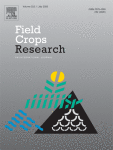Ver ítem
- xmlui.general.dspace_homeCentros Regionales y EEAsCentro Regional CórdobaEEA ManfrediArtículos científicosxmlui.ArtifactBrowser.ItemViewer.trail
- Inicio
- Centros Regionales y EEAs
- Centro Regional Córdoba
- EEA Manfredi
- Artículos científicos
- Ver ítem
Row spacing and growth habit in peanut crops : effects on seed yield determination across environments
Resumen
Narrowing row spacing was expected to improve peanut crop performance, but the responses varied depending upon the evaluated environment and the growth habit of the plant. To clarify apparent inconsistencies, two cultivars with contrasting growth habits were sown at 52 cm and 70 cm row spacings in field experiments carried out in four environments. Vegetative and reproductive traits were evaluated. The leaf area index was always higher in the 52 cm than
[ver mas...]
Narrowing row spacing was expected to improve peanut crop performance, but the responses varied depending upon the evaluated environment and the growth habit of the plant. To clarify apparent inconsistencies, two cultivars with contrasting growth habits were sown at 52 cm and 70 cm row spacings in field experiments carried out in four environments. Vegetative and reproductive traits were evaluated. The leaf area index was always higher in the 52 cm than in the 70 cm row spacing, independently of the growth habit. Similarly, the light attenuation coefficient (k) was higher under narrow than under wide rows, but the cultivar with procumbent growth habit had a larger k and increased slightly the intercepted radiation respect to the erect type. These responses of the procumbent cultivar were driven by its lateral arrangements towards neighboring rows and its longer cycle duration. Narrow rows contributed to intercept approximately 14% more radiation than wide rows. These responses determined an improved biomass production through increases in the crop growth rate during the pod set period, with subsequent increases of the radiation use efficiency of this phase. Narrow row spacing enhanced seed and pod yields independently of the growth habit, but the relative importance of each seed yield component varied between cultivars. Seed numbers were more relevant for the erect growth habit, concurrently with the marked increase in total flower numbers of this cultivar. Seed weight was more relevant for the procumbent growth habit. On one hand, the erect growth habit caused a larger relative variation in seed and pod yields across environments than the procumbent one, particularly at narrow row spacing. On the other hand, the erect growth habit showed the lowest yield under wide rows. The small differences in biomass production between growth habits but the large difference in harvest index (procumbent > erect) contributed to an enhanced and more stable seed yield of the procumbent type, particularly when grown under narrow rows and linked to the large seed size of the runner cultivar. Results suggest that farmers should consider reducing row spacing as a way to increase peanut yield in the region under analysis.
[Cerrar]

Autor
Haro Juarez, Ricardo Javier;
Carrega, Willians C.;
Otegui, María Elena;
Fuente
Field Crops Research 275 (1) : 108363. (January 2022)
Fecha
2022-01
Editorial
Elsevier
ISSN
0378-4290
Documentos Relacionados
Formato
pdf
Tipo de documento
artículo
Proyectos
(ver más)
INTA/2019-PpC-1.5.1-CULT.IND-001/2019-PpC-1.5.1-CULT.IND-001/AR./Programa por Cadena Cultivos Industriales
Palabras Claves
Derechos de acceso
Restringido
 Excepto donde se diga explicitamente, este item se publica bajo la siguiente descripción: Creative Commons Attribution-NonCommercial-ShareAlike 2.5 Unported (CC BY-NC-SA 2.5)
Excepto donde se diga explicitamente, este item se publica bajo la siguiente descripción: Creative Commons Attribution-NonCommercial-ShareAlike 2.5 Unported (CC BY-NC-SA 2.5)

